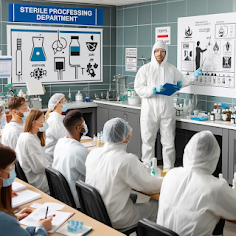By Martin Li, M.A., CRCST, CER, CIS, CHL
As an SPD
Educator, ensuring the safety and health of employees in sterile processing departments
(SPDs) is not just a priority—it’s a critical aspect of daily operations. SPDs
play a vital role in maintaining infection control and patient safety, but they
also pose numerous risks to workers. Here, I share strategies to mitigate these
risks, drawing on insights from OSHA officials and best practices from
authoritative sources.
1.
Implement Comprehensive Fall Protection Measures
Falls are a
significant hazard in many workplaces, including healthcare. According to Eric
Harbin, OSHA's Region 6 Administrator, fall protection violations remain a top
concern, leading to numerous injuries and fatalities annually. To prevent falls
in SPDs:
- Conduct Regular Risk
Assessments:
Identify areas where falls could occur, such as wet floors or high storage
areas.
- Install Proper Equipment: Ensure the availability of
anti-slip mats, guardrails, and appropriate ladders.
- Training and Awareness: Regularly train staff on fall
prevention and the proper use of safety equipment.
2.
Enhance Hazard Communication (HaxCom) Programs
Effective
communication about workplace hazards is essential for safety. Harbin
emphasized the importance of having a robust hazard communication (HazCom)
program to manage chemical risks, which are prevalent in SPDs due to the use of
various cleaning and disinfecting agents. Key steps include:
- Develop a Written HazCom
Program:
Outline procedures for handling chemicals, including proper labeling and
safety data sheets.
- Employee Training: Conduct regular training
sessions to ensure all employees are aware of chemical hazards and safe
handling practices.
- Regular Updates: Keep the HazCom program updated
with new chemicals and revised safety protocols.
3.
Implement Ergonomic Solutions
Musculoskeletal
disorders (MSDs) are common in healthcare due to repetitive motions and heavy
lifting. Harbin noted that addressing ergonomic hazards through proper
workplace design can significantly reduce these injuries. Strategies include:
- Engineering Controls: Utilize mechanical lifts and
adjustable workstations to minimize manual handling of heavy objects.
- Administrative Controls: Rotate tasks among employees to
reduce repetitive strain and implement mandatory breaks.
- Personal Protective Equipment
(PPE): Provide
supportive footwear and padding to reduce the impact of repetitive tasks.
4.
Regular Machine Guarding Inspections
Machine
guarding violations are a frequent cause of injuries in healthcare settings,
particularly in areas with sterilization and packaging equipment. Harbin
highlighted the high incidence of serious violations related to inadequate
machine guarding. To mitigate these risks:
- Conduct Regular Inspections: Ensure all machinery has
appropriate guards and safety features.
- Training: Train employees on the
importance of machine guarding and safe operation practices.
- Maintenance: Regularly maintain and repair
equipment to ensure all safety features are functional.
5. Foster
a Culture of Safety and Employee Participation
Creating a
culture where safety is a core value and employees are actively involved in
safety programs can significantly enhance workplace safety. Harbin stressed the
importance of worker participation in identifying and addressing hazards.
Effective approaches include:
- Encourage Reporting: Create a non-punitive
environment where employees feel comfortable reporting hazards and
near-misses.
- Safety Committees: Establish safety committees
that include employee representatives to discuss and address safety concerns.
- Continuous Improvement: Regularly review and improve
safety policies and procedures based on employee feedback and incident
analysis.
Sterile Processing Department Safety Meeting: Employees gathered around a table discussing safety practices and procedures, equipped with safety posters, charts, a whiteboard, and personal protective equipment (PPE).
These
visuals illustrate the importance of safety measures and training in
maintaining a safe working environment in SPDs.
Conclusion
Ensuring the safety and health of employees in healthcare sterile processing requires a comprehensive approach that includes fall protection, effective hazard communication, ergonomic solutions, machine guarding, and fostering a culture of safety. By implementing these strategies and leveraging OSHA's resources and guidelines, healthcare facilities can create a safer working environment, ultimately improving employee well-being and patient care.
References
1. Safety+Health Magazine. (2023). OSHA’s Top 10 most cited standards for fiscal year 2023. Retrieved from Safety+Health Magazine
2. Occupational Safety and Health Administration. (2023). Hazard Communication Standard. Retrieved from OSHA
3. Bureau of Labor Statistics. (2023). Musculoskeletal Disorders Data. Retrieved from BLS
4. National Safety Council. (2023). Machine Guarding Guidelines. Retrieved from NSC
5. OSHA. (2023). Worker Participation in Safety Programs. Retrieved from OSHA
6. OSHA. (2023). Fall Protection Standard. Retrieved from OSHA
7. National Institute for Occupational Safety and Health. (2023). Ergonomics and Musculoskeletal Disorders. Retrieved from NIOSH
8. American Society of Safety Professionals. (2023). Safety and Health Management Programs. Retrieved from ASSP
9. Centers for Disease Control and Prevention. (2023). Workplace Safety and Health Topics. Retrieved from CDC
10.International Labor Organization. (2023). Safety and Health at Work. Retrieved from ILO







Thanks for reviewing and sharing your insights.
ReplyDelete